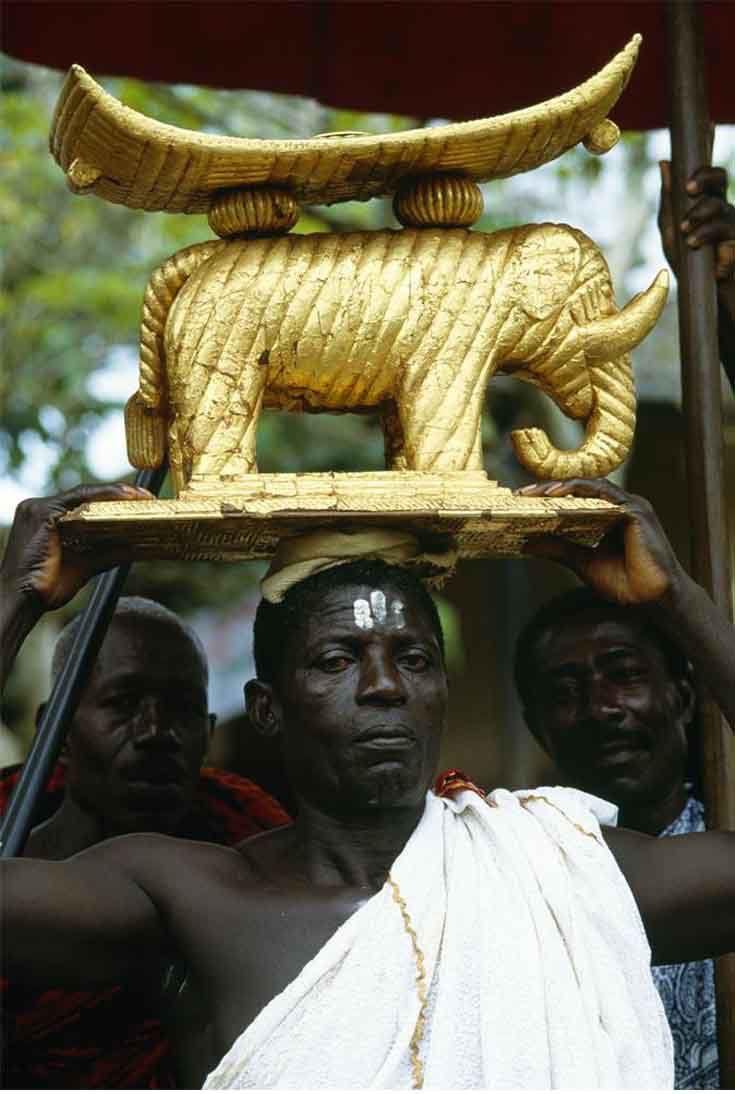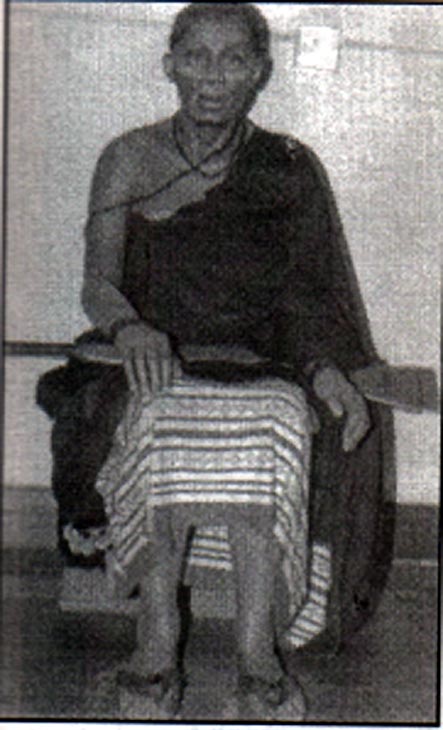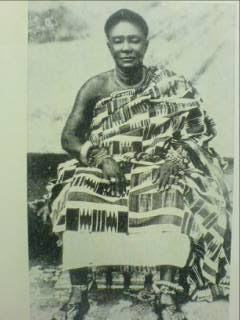
An A Gold Stool Attendant
Caring Sikadwa Kofi in a Procession

Gold Elephant for the
25th Jubilee Celebration
WHAT KINDS OF QUEEN MOTHERS ARE THERE? THERE ARE TWO KINDS: MARKET QUEENS & ROYAL QUEENS |
|---|
 Yam Queen Mother has The most Power in the Market |  Plantain Queen Mother |  Tomatoe Queen Mother |
|---|
WHAT IS THE ROLE OF AN ROYAL QUEEN MOTHER? |
|---|
This study commemorates the role queen mothers of Ashanti. There are five queen mothers and each one has a story to tell about her role in leading the Ashanti people. It can be said “That behind every great man there is even a greater woman”. That couldn’t have been truer concerning the Ashanti nation at the beginning of their colonialism during the early twentieth century. The British wanted to colonize the Ashanti, but first the Ashanti must meet certain requirements favorable to the British. One of which was to let the Governor place his backside on the golden stool, then the other condition was to let the Governor take the golden stool to Great Britain for keepsake. To oppose the order and disrespect given by the British Governor the Ashanti need a strong man, but the Ashanti didn’t have strong man so a strong woman had to pay the price instead. The following is her story: | |||||||||||||||||||||||||||||||||||||||||||||||||||||||||||||||||
|---|---|---|---|---|---|---|---|---|---|---|---|---|---|---|---|---|---|---|---|---|---|---|---|---|---|---|---|---|---|---|---|---|---|---|---|---|---|---|---|---|---|---|---|---|---|---|---|---|---|---|---|---|---|---|---|---|---|---|---|---|---|---|---|---|---|
|
& DIGNATY FOR ASHANTI KINGDOM |
 Queen Mother Yaa Asantewaa1 |  War Queen Yaa Asantewaa1 |
|---|---|
She (Queen Mother Yaa Asantewaa1) was born in 1863 at Ejisu, near Kumasi, in Ashanti and later became the queen Mother of Ejisu, brave and fearless as she was, she led the men of Ashanti or the Ashanti Warriors” to fight the British. Information was taken from http://rainqueensofafrica.com Asantehewaa Queen Mother Yaa Asantewaa1 reigned during the time of Asantehene Prempeh I. She was the first to serve with Asantehene Prempeh I. Yaa Asantewaa1 played a key role in making the British respect the Ashanti people. The men of the nobility were crawling on their hands and knees in London trying to plead their case before the court of England. Mother Yaa convinced the men of Ashanti that the colonialist had taken things too far by disrespecting the Golden Stool and it was time to declare war on the British. She threw everything she had at the British. By the time British and Yaa Asantewaa1quit taring things up the entire Ashanti Kingdom was in shambles. The Ashanti lost the war, but the British were careful with Ashanti people after that, because they did not know when another woman might try to start something. |
|---|
 Asantehene Prempeh I |  Prempeh I in prison exile |
|---|
RAIN QUEENS OF AFRICA http://rainqueensofafrica.com A dedicated hub of information promoting awareness of Africa's female leadership traditions including Rain Queen Mothers, Queen Mothers, Queens, Priestesses, Shaman Healers, Warriors and their associated roles, customs and history. Yaa Asantewaa was an Edwesohemaa (queen mother of the Edweso tribe of the Asante) in modern day Ghana. At the time, the Gold Coast (west-central Africa) was under British military control. The British supported their campaigns against the Asante with taxes levied upon the proud Asante people. In addition, they took over the state-owned gold mines thus removing considerable income from the Asante government. Missionary schools were also established and the missionaries began interfering in local affairs. Yaa Asantewaa is often credited with empowering the people to rise up against the British. Early Life According to transmitted family traditions provided by the descendants of Yaa Asantewaa as well as by other well-informed sources, she had a normal childhood. This meant that she performed such mundane domestic chores as fetching water from the stream, doing the dishes, sweeping, running errands and assisting with farm work. When she attained the age of puberty, she had the necessary rite of passage for Akan girls (bragro) performed for her. She then went on to marry Owusu Kwabena, a son of Asantehene Osei Bonsu. As the only (surviving) daughter of her mother, this was a very important stage of her life because the hopes for the continuity of her specific lineage depended on her. Yaa Asantewaa took her role as a matriarch very seriously. She appeared to have married early. When she was about fifty-six years old, her third grandchild, Kofi Tene, already had about six children. She satisfied this important requirement by producing her only child, a daughter, Amma Seiwaa Boankra, from the only marriage that she was known to have contracted. Incidentally, Ama Seiwaa was to produce eleven children herself – three daughters and eight sons. One of these sons, Kofi Tene, later succeeded to office as Edwesohene Akwasi Afrane Kuma. He was abducted and exiled by the British in 1896 with Asantehene Agyeman Prempe I and other important advisors After the Asante Wars.[1] Yaa Asantewaa Wars Near the end of the 19th century, the British exiled King Prempeh from the hinterlands of the gold coast (present day Ghana), in an attempt to take over the entire country. By 1900, still not gaining control, the British sent a governor to the city of Kumasi, the capital of the Ashanti, to demand the Golden Stool, the Ark of the covenant of the Ashanti people. The Golden Stool was the supreme symbol of the sovereignty and the independence of the Ashanti, a fierce and warlike people who inhabit dense rain forests of what is now the Central portion of Ghana. The Governor in no way understood the sacred significance of the Stool, which according to tradition, contained the soul of the Ashanti. Yaa Asantewaa was present at the meeting with the governor and chiefs. When the meeting ended, and she was alone with the Ashanti Chiefs, she said, “Now I have seen that some of you fear to fight for our King. If it were in the brave days of old, the days of Osei Tutu, Okomfo Anoyke and Opulu Ware, Ashanti Chiefs would not sit down to see their King taken away without firing a shot. No white man could have dared speak to Ashanti Chiefs in the way the Governor spoke to you chiefs this morning. If you men will not go forward, then we the women will. I will call upon my fellow women. We will fight the white men until the last of us falls in the battlefields.” Yaa Asantewaa’s speech stirred up the men, The Ashantis, led by Yaa Asantewaa, fought very bravely. The British sent 1400 soldiers with guns to Kumasi, capturing Yaa Asantewaa and other leaders and sent them into exile. The war with the British started in 1805 and ended some 100 years later. Yaa Asantewaa’s War was the last major war led by an African woman in the era of colonialism. [2] http://rainqueensofafrica.com Notes 1. ? http://www.jendajournal.com/vol1.1/donkoh.html 2. ? Van Sertima, Ivan; John Henrik Clarke, others (April 1984). Black Women in Antiquity. Transaction Publishers. ISBN 0-87855-982-5. End of Article - |
|---|
Queen Mother is a title given to a woman who heads the Ashanti nation. The Queen Mother is biologically related to the Asantehene, but she in most cases is not his mother or his wife. Kings are made through a matrilineal process. If you follow the succession of Queen Mothers then it is much easier to tell who the next Asantehene may be. The political structure is patriarchy not matriarchy. Queen Mother has power equal to the Asantehene because of a net work of biologically kin brothers and uncles devoted to her. She uses them to rock the boat whenever she has to.
| |||||||||||||||||||||||||||||||||||||||||||||||||||||
|---|---|---|---|---|---|---|---|---|---|---|---|---|---|---|---|---|---|---|---|---|---|---|---|---|---|---|---|---|---|---|---|---|---|---|---|---|---|---|---|---|---|---|---|---|---|---|---|---|---|---|---|---|---|
Queen Mother Yaa Asantewaa1 was sent to prison by the British for life without parole. Asantehene Prempeh I was imprisoned for war crimes and later set free on parole. Asantehene Prempeh I was pardoned and sent back as a private citizen, but order in the Ashanti Kingdom did not restore until Prempeh I was reinstated as king of Ashanti. Nana Kwaadu Yiadom was Prempeh I biological sister. She became queen mother until Asantehene Prempeh I death died in 1931. When Nana Otumfoe Sir Osai Agyemang Prempeh II became Asantehene she was his queen mother until she died in 1945. In picture on the left we can see Queen Mother Yaa Asantewaa1 seated next to her brother Asantehene Nana Prempeh I. Prempeh I successor Osai Agyemang Prempeh II can be seen on the right. The first photo posted showing Asantehemaa Nana Kwaadu Yiadom II is the most popular picture, yet it is very poorly printed. I have to use it because most people are familiar with that picture. If you scroll down to the next photograph depicting Prempeh I & Nana Kwaadu Yiadom you will see that the above picture is very similar to the one of the second one depicting the siblings. Someone crudely cut out her image from one of the sibling photographs and botched up her portrait. Nana Kwaadu Yiadom II, (1917 - 1945) sitting in state during a Kumasi durbar. Nana was the sister of Nana Prempeh I. Nana will be remembered for her joyous Adowa dance during the restoration of the Asante Confederacy, which led to the Governor alluding to her Kentenkye hair design as a ' dancing crown', from which the word dansinkran( having overshadowed the proper name ) has its origins. She was a formidable Queen in her own right. ( Accounts of those in the know )...Credit...Meyerowitz Sienna text was written by © Claude Lockhart Clark November 21, 2014 The picture and information in gray text which follows above are taken from Nana Akrase Blogspot @ Google - http://akrase.blogspot.com/2008_01_01_archive.html |
THE NEED FOR A 20th CENTURY MONARCH |
|---|
 Nana Ama Serwaa Nyarko II |
 Otumfuo Opoku Ware II 1970 - 1999 |  Agyeman Prempeh II 1933 - 1970 |
|---|
 |
|---|
|
The Golden Stool reemerges from obscurity during the reign of Asantehene Nana Otumfoe Osai Agyemang Prempeh II. Ashanti once again feel united in a single purpose and direction. | |||||||||||||||||||||||||||||||||||||||||||||
|---|---|---|---|---|---|---|---|---|---|---|---|---|---|---|---|---|---|---|---|---|---|---|---|---|---|---|---|---|---|---|---|---|---|---|---|---|---|---|---|---|---|---|---|---|---|
|
During the reign of Prempeh I the British authorities were mistreating Ashanti people and as the last straw they wanted to disrespect the golden stool as well, so it was decided to hide it and put it away. When Otumfuo Sir Agyeman Prempeh II came to power the golden stool was brought out of hiding and displayed on special occasions. The golden stool was once again apart of Ashanti State activities. Golden Sool appears in public once every 5 years.
|















